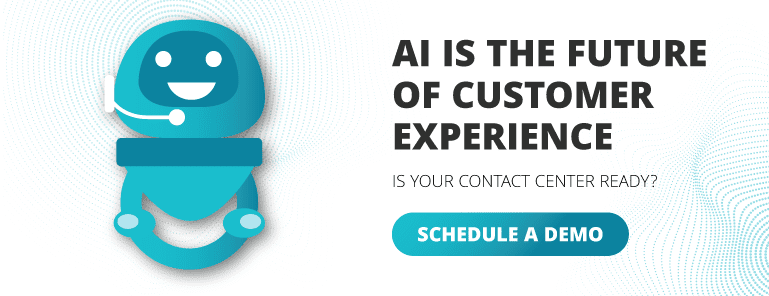The days of long hold times, robotic scripts, and disconnected service experiences are over. (Cue the collective sigh of relief.) Today’s customers expect speed, personalization, and consistency across every interaction—whether they call in, message on social media, or use self-service options.
The difference between good and great customer care lies in execution. Simply answering customer inquiries is no longer enough. You must anticipate needs, reduce friction, and deliver proactive, seamless experiences across all touchpoints.
A study by PwC found that 86% of customers are willing to pay more for a great experience, yet only one in three say they actually receive it. That gap presents a massive opportunity—and a risk—for contact centers.
So, how can your contact center not only keep up but get ahead? These 12 essential tactics will define modern, efficient, and customer-centric support in 2025.
1. Add AI into Your Customer Care Strategy
AI is not here to replace agents—it is here to make them more effective. Smart AI tools can:
- Automate routine inquiries (e.g., tracking orders, account updates) so agents can focus on complex cases
- Analyze sentiment in real-time to detect frustration and adjust service responses accordingly
- Improve first-contact resolution rates by routing customers to the right agent the first time
- Offer predictive recommendations based on past interactions, making service more proactive
How to Add AI Without Losing the Human Touch
The key to AI success in customer care is balance. AI should handle transactional tasks, while your human agents focus on relationship-building and complex problem-solving.
One best practice is to use AI-driven call summaries to eliminate the need for agents to take extensive notes, saving time and improving accuracy. AI can also surface relevant customer history in real time, so agents can provide more personalized, efficient service.
2. Train Agents to Solve Problems Before They Happen
A reactive contact center waits for customers to report problems. A proactive contact center anticipates them.
Steps to Shift from Reactive to Proactive Service
- Use predictive analytics to detect common customer pains. If billing errors often lead to support calls, reach out before customers notice.
- Train agents to recognize early warning signs of dissatisfaction, like repeated contacts or negative survey responses.
- Create automated alerts that notify customers of potential issues before they arise, like delayed shipments or scheduled maintenance.
Salesforce and Netflix are masters at this. They tell customers about potential service disruptions before they happen, often including an overly cautious timeframe for service to return. This simple act builds massive trust between customers and companies. Plus, since customers are in the know, they won’t need to call in and ask why service is down, reducing your inbound call volume and avoiding long hold times.
3. Incorporate Omnichannel Support
Customers expect to move seamlessly between chat, phone, email, and social media without repeating themselves. The problem? Most contact centers still treat these as separate interactions.
How to Ensure Consistency Across Channels
- Use a unified customer view so agents have full context, regardless of channel.
- Implement omnichannel analytics to measure performance across all platforms.
- Set up automated workflows that transfer customer data between channels instantly.
4. Use Self-Service to Improve Your Customer Experience
If your self-service is just an FAQ page, you don’t have self-service.
Your customers expect to find answers to their questions as soon as they even think they might have a question. And shout out to the millennials here, a huge portion of our spending population has massive anxiety around using a phone to actually speak with other people. I don’t know, maybe we’re all still scarred from the late fee calls Blockbuster use to make. It’s our job, as part of customer care, to give these people the tools to solve their issues without tagging in an agent.
How to Make Self-Service Work for Customers
- AI-powered chatbots that resolve common issues instantly.
- Dynamic knowledge bases that update in real time based on customer questions.
- Intelligent IVAs and IVR systems that recognize customer history, predict intent, and streamline call routing for faster resolutions.
In a joint study from almost 15 years ago, Forrester and Oracle looked at the business costs of handling support across customer service channels. The result? Self-service can reduce costs by $11 per call! Considering new tech, like chat bots and AI, and modern customer adoption rates, the savings are only growing.
5. Invest in Your Agent Experience
Burnt-out, unengaged agents cannot deliver great service. Yet, the contact center industry has one of the highest attrition rates, often exceeding 30%.
How to Retain and Empower Your Agents
- Provide real-time coaching tools powered by AI
- Reduce after-call work using AI-generated call summaries
- Offer career development programs to keep agents engaged
When agents feel valued, they stay longer, perform better, and create happier customers.
6. Make Customer Interactions Truly Personal
Customers do not want to feel like just another ticket. They expect personalized, relevant support based on their history and preferences.
How to Deliver Real Personalization
- Use AI-driven insights to offer tailored recommendations
- Enable proactive outreach for frequent customers with personalized offers
- Train agents to use customer data naturally in conversations
A simple, “Hi Sarah, I see you recently contacted us about your billing issue. How can I help today?” can make all the difference.
7. Use AI-Powered Sentiment Analysis
AI-backed sentiment analysis can flag dissatisfaction before a customer churns—allowing your team to course-correct in real time.
How to Add Sentiment Data into Workflows
- Capture real-time sentiment scoring and adjust agent responses
- Trigger automated alerts when sentiment trends indicate potential churn
- Use post-call sentiment insights to coach agents and refine approaches
8. Build a Voice of the Customer (VoC) Program
Your best insights come from your customers.
How to Build a Strong VoC Program
- Collect feedback from surveys, chat logs, and social media.
- Identify recurring themes and prioritize pain points.
- Act on feedback and close the loop by informing customers of changes based on their input.
9. Reduce Friction in Escalation Paths
Customers hate repeating themselves. Smart escalation workflows connect them to the right agents faster.
Best Practices for Smarter Escalations
- Implement AI-driven routing based on issue complexity and customer history
- Enable real-time data sharing between support tiers
- Create clear pathways for escalating urgent issues
10. Prioritize Social Media Customer Care
Most people want brands to respond within a day, and even the first hour, after they post on social media, according to Sprout Social.
How to Manage Social Media Customer Support
- Monitor brand mentions in real time
- Train social agents to know when to escalate
- Use AI-powered categorization to route social inquiries effectively
11. Automate Repetitive Tasks, But Keep the Human Touch
Where Automation Works
- Ticket categorization
- FAQ responses
- Call summarization
Where Humans Matter Most
- Complaint resolution
- Complex troubleshooting
- High-value customer interactions
Automation should support, not replace, human agents.
12. Measure What Actually Matters
Success in customer care is about more than just CSAT scores. While customer satisfaction is important, relying solely on it can paint an incomplete picture of your contact center’s performance. To truly understand and improve customer experience, you need to track a balanced mix of efficiency, effectiveness, and customer perception metrics.
Metrics to Track in 2025
- Customer Effort Score (CES): Measures ease of resolution
- First Contact Resolution (FCR): Measures efficiency
- Net Promoter Score (NPS): Predicts customer loyalty
- Sentiment: Assesses customer emotions during an interaction
How to Make Data-Driven Improvements
- Identify patterns—Are certain agents resolving issues faster? What are they doing differently?
- Coach against the right data—Use insights from sentiment analysis and FCR to train agents on what actually improves customer experience.
- Refine processes—If a common issue is causing repeat contacts, fix the root cause rather than treating symptoms.
It’s tempting to hyper-focus on traditional efficiency metrics like average handle time (AHT) and call volume, but speed should never come at the expense of quality customer care. A low AHT might look good on paper, but if customers leave frustrated and call back, your FCR and CES will suffer, leading to higher operational costs and, worse yet, customer churn.
Where to Start
Implementing all of these customer care tactics at once probably seems like an outrageous and impossible task. You’re right. That’d be an outrageous ask. You can add a couple into your strategy each quarter, evaluate, refine, then add a couple more. Continuous evolution is the key to long-term success in the modern contact center.
If your contact center is struggling with long resolution times, inconsistent service, or agent burnout, start by identifying the biggest pain points. Then, choose a few high-impact tactics that will deliver quick wins and lay the foundation for long-term transformation.
Next Steps:
- Pick three tactics to implement next quarter, prioritizing the ones that will have the biggest impact on your operation.
- Track performance using customer experience metrics like Customer Effort Score (CES), First Contact Resolution (FCR), and Net Promoter Score (NPS).
- Refine and expand based on data-driven insights, continuously evolving your customer care strategy.
Customer care isn’t just a department—it is the entire experience your customers have with your company. The most competitive contact centers this year will be those that embrace technology, invest in their teams, and put customers first.













